
Forest river near Santa Cruz.
Part 5. The Bay Area
Few urban areas in the world are as interesting for a naturalist
as San Francisco Bay Area with its extensive salt marshes, forests, sand dunes,
Mediterranean grasslands, and offshore islands. I lived there for six years, and
each weekend was an adventure. Even if I had no time to leave the city, there
was always something interesting going on around. Just imagine what a terrible
torture it was: to live in a place like this, and to have to spend five days a
week at work!
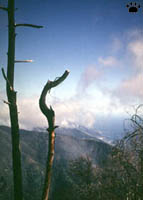
View from Cone Peak,
Santa Lucia Mountains. | If you only have time to visit
one place in California, I'd recommend Santa Lucia Mountains south from
Monterey. This wonderful area has everything: coniferous forests and oak
savannas, vernal pools and giant redwoods, unique plants and rare animals,
rugged coast and picteresque fog, migrating whales and elephant seals,
kelp beds and sea otters, spring wildflowers and clear streams, majestic
condors and tiny salamanders, plus stunning views of the Pacific Ocean. |
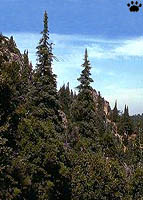
Santa Lucia fir (Abies
bracteata), Cone Peak. |
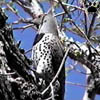 | 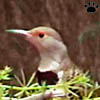 | 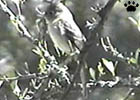 | 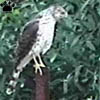 | 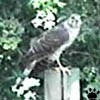 | | Northern flicker (Colaptes
auratus), Los Gatos | Pacific-slope flycatcher
(Empidonax difficilis), Los Gatos. | Cooper's hawk (Accipiter
cooperi), Los Gatos |
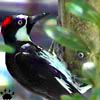
Acorn woodpecker
(M. formicivorus),
Los Gatos. | Even in the cities of California, there is
some interesting wildlife. Dozens of bird species nest in residential areas;
bats live under roofs; salamanders hide in stone fences; at night, deer,
skunks and raccoons move quietly along dark streets. Some city parks have
higher density of bird and mammal populations than the forests outside
the populated areas. Of 13 native owl species, 8 can be seen in cities
and parks. |

Red-breasted sapsucker
(Sphyrapicus ruber),
Los Gatos. |
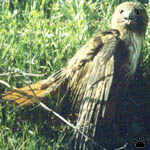 Red-tailed hawk (Buteo jamaicensis), Red-tailed hawk (Buteo jamaicensis),
Vallejo. | 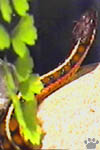
Garter snake (Thamnophis
sirtalis), Los Gatos. | 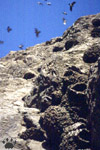
Cliff swallows (Hirundo pyrrhonota), Ventura. | 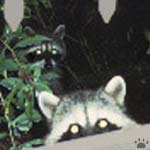 Raccoons (Procyon lotor), Raccoons (Procyon lotor),
downtown Berkeley. |
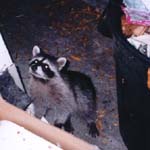 |  | 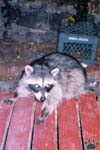 | 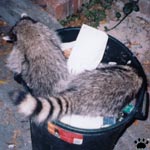 | | Raccoons (Procyon lotor), Berkeley |
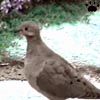 | 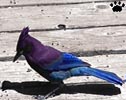 | 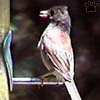 | 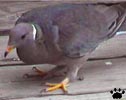 | 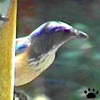 | 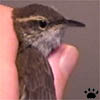 | Some of the common
birds of our garden in Santa Cruz Mountains. Upper row, left to right:
mourning dove
(Zenaida macroura), Steller's jay (Cyanocitta stelleri),
American junco (Junco hyemalis), band-tailed pigeon (Columba
fasciata), Western scrub jay (Aphelocoma californica). Lower
row, left to right: house wren
(Troglodytes aedon, rescued after
flying into a window), hermit thrush (Catharus guttatus). | 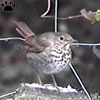 |
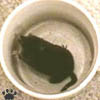
Shrew-mole
(Neurotrichus gibbsii),
in a tea cup, Los Gatos. | Some city inhabitants are very difficult
to see, such as shrews (Sorex), subterranean pocket gophers (Tomomys
bottae) and broad-footed moles (Scapanus latimanus). In San Francisco
Bay Area, high winter tides provide a chance to see rare and shy creatures of
tidal marshes - rails and endemic salt marsh harvest mouse (Reinthrodontomys
raviventris). |

Shrew-moles are cute
and friendly, but don't
make good pets. |

Pocket gopher,
Monterey. |

Shrew S. throwbridgii,
Los Gatos. |

Western harvest mouse
(R. megalotis), Los Gatos. |

Clapper rail (Rallus
longirostris), Palo Alto. |

Shrew S. throwbridgii,
Los Gatos. |

Pocket gopher,
Berkeley. |
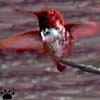 |  |  |  |  | | Some of Californian
hummingbirds, left to right: Selasphorus costae, Amazilia latirostris,
S. sasin, S. annae, S. platycercus. |

Anna's hummingbird feeding
during a snowstorm, Los Gatos. | More than half a dozen species of hummingbirds
breed in California, but only Anna's hummer (Selasphorus annae)
is hardy enough to winter in the northern part of the state. It is also
more closely associated with human settlements than others, being the most
common species at hummingbird feeders. |

Nest of Anna's hummingbird,
Santa Rosa. |
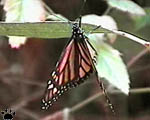 | Wintering monarchs (Danais phlexippus), Santa Cruz. |  |
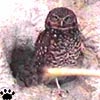
Burrowing owl
(Athene cunicularia),
Oakland Airport. |

Northern saw-whet owl
(Aegolius acadicus),
McArthur Falls. | There are 13 owl species in California.
At least nine of them can be seen in cities and parks. Others are more
difficult to find, but all are fun to look for and observe. |
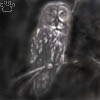
Great gray owl
(Strix nebulosa),
Yosemite. |
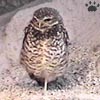
Burrowing owl
(Athene cunicularia),
Oakland Airport. |
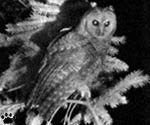 | 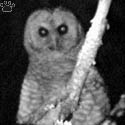 |  | 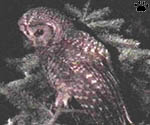 | | Spotted owls (Strix
occidentalis), Mosquito Ridge. |

Western screech-owl
(Otus kennikotti),
Devil's Punchbowl. | Our neighbor Mike Parker has installed
a webcam in a nestbox occupied by a family of Western screech-owls. Every
May, we can enjoy watching the chicks grow. You can see Mike's site at
www.parkers.to/owls/ Below are
some of the shots I downloaded from his camera last year. |

Western screech-owl
(Otus kennikotti),
Los Gatos. |
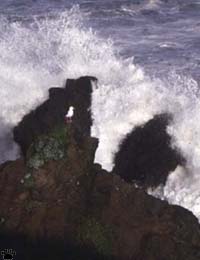
Western Gull (Larus occidentalis), Salt Point. |
Gulls are even more ubiquitous than owls.
15 resident species of similarly looking gulls, plus endless vagrants,
subspecies, individual varieties and hybrids, provide endless fun for birdwatchers.

Western gull, Monterey. |
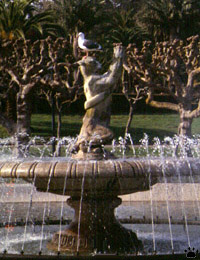
Western Gull, San Francisco. |
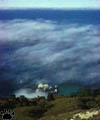
Coast south from Big Sur, California |
Part 6: Baja California
Back to Part 4
Home |